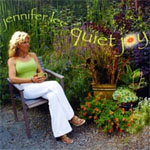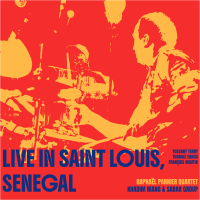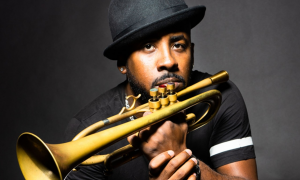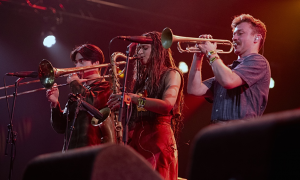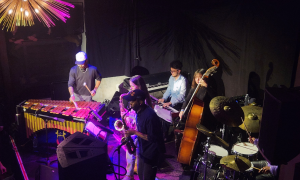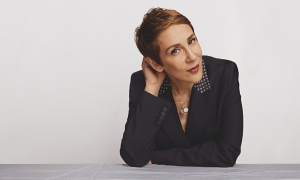Home » Jazz Articles » Live Review » Vision Festival 2009: Day 3
Vision Festival 2009: Day 3
Yvonne Meier's Scores / David Budbill / William Hooker's Bliss Trio—A Silent Film/Live Music Project / Jason Jordan and Friends / Ernest Dawkins New Horizons Ensemble / Sunny Murray Philly Quartet
14th Annual Vision Festival
Abrons Arts Center
New York City
June 11, 2009
Day three was one of surprises with some intriguing and largely successful collaborations among jazz, dance, film and poetry, all underscoring that the much-touted concept of the Vision Festival as a multi- disciplinary event stood proud without need for hype.
- Yvonne Meier's Scores
- David Budbill
- William Hooker's Bliss Trio—A Silent Film/Live Music Project
- Jason Jordan and Friends
- Ernest Dawkins New Horizons Ensemble
- Sunny Murray Philly Quartet

It didn't seem promising to begin with. Downtown dance veteran Yvonne Meier's new project Scores stemmed from the idea of suggesting short improvisational inputs to which musicians and dancers inter- react. So Meier sat at the side of the stage with a mic giving the performers instructions: these were the so- called "scores." On stage was a trio of young musicians (Michael Jaeger, tenor saxophone; Dave Gisler, guitar; and Christian Jaeger-Brown, drums and percussion) with up to three dancers (Arturo Vidich and Christopher Williams from New York and Gabi Glinz from Switzerland), all with longstanding working relationships with the choreographer.
Swiss native Meier would give instructions like "merciless music," but allow the musicians and dancers a lot of leeway to explore what this might mean. The results sometimes seemed overly theatrical and, with the artifice intentionally shown, recalled a rehearsal rather than performance. But once accustomed to the situation, it was fascinating to see how the performers responded to instructions, like "Start a melancholic solo Arturo to the melancholic music of the saxophone. You might want to be a dog that is lame." The dancers were very athletic and very "hands on" with each other, Glinz at one point simulating (I hope) the pulling out of one man's chest hair and then forcing him to eat it.
Free of stylistic instruction, the young musicians proved very adept with free improv vocabulary—the instruction "Only the music plays" generating a passage of breathy saxophone played without a mouthpiece, hands pattering on percussion and then thighs and floor, and small scratchy guitar shards, which grew incrementally until one of the dancers returned. Unconventional textures abounded as when Gisler brought forth muffled and truncated textures courtesy of a Metrocard threaded between his strings.
There was humor too. Meier's instruction for two wolves to come on stage transmuted the two male dancers into animals warily circling each other on all fours until the further instruction "Be threatening. Go scare the audience" led to some disobedience with one wolf advancing on Meier and savaging her leg, much to the amusement of the audience and Meier herself, until she barked "Back off!"
"Show some movement you haven't shown tonight" elicited some Brunoesque camping at first before one dancer fell off the stage in a controlled way at the instruction "Find a meaningful end." Very amusing and very well done.
David Budbill
Several performance spaces were available in the Abrons Arts Center, allowing programming of short mixed-media events while changeovers were happening on the main stage. Timing hiccups meant that it wasn't always wise to linger as it was very easy to miss the start of the next set. However it would have been criminal to miss poet David Budbill's "The Fire of Compassion / Meaning of Jazz in Words and Music" in the Downstairs Theater, accompanied by William Parker and Hamid Drake in a master class of rhythmic alchemy.

Budbill's piece was an assemblage of quotes about jazz stretching from Ellington to Hamid Drake, delivered in a low-key conversational style with bass and a pared- down drum-kit accompaniment. Many of the quotes were thought-provoking: "Improvisation dates back to the time of Beethoven, but it was the American Negro who introduced four people improvising together, not Paul Whiteman." It was utterly beguiling to be able to observe Parker (pictured right) and Drake up close and personal. Drake was a rhythm section in himself on just snare, hi hat and one cymbal, but he also contributed some lovely interplay on frame drum with Parker on shakuhachi. Parker was almost dancing as he embraced his bass so irrepressible were the grooves.
Budbill finished with a quote from saxophonist Byard Lancaster, which ended "Like a love supreme," whereupon Parker hit the Coltrane riff and ignited the room in wonderful syncopation, with first Drake then the whole audience joining in chanting "A Love Supreme." It was one of those moments that make the hairs on the back of your neck stand up and the highpoint of the evening.
William Hooker's Bliss Trio—A Silent Film/Live Music Project

Composer and drummer William Hooker has long had a fascination with incorporating other art forms into his performance, be it his own poetry or films, like those of experimental film-maker Stan Brakhage, often breaking free of his free jazz roots to encompass rock and noise sensibilities in the process. But for his Silent Film Project, which he has been touring on and off since 2007, Hooker and bandmates Darius Jones on alto saxophone and Adam Lane on bass, extemporized accompaniment in real time to a screening of black film- maker Oscar Micheaux's 1920s classic Symbol of the Unconquered.
A fledging industry known as "race movies" existed in the United States from 1910 to the end of World War II. Made predominantly by blacks (especially in the 1920s) for black audiences, these independent films emerged from a direct response to Jim Crow theaters and an exclusionary Hollywood system. They were a part of the Afro-American community's attempts in countering and providing alternative images to the stereotypes so prevalent in mainstream culture.
Thought lost for decades and only restored in the 1990s, though with a crucial reel missing, in Symbol of the Unconquered the black hero holds his ground and chivalrously protects a lovely light-skinned mulatto neighbor (who is passing as white) against a local gang of thieves and hooded, torch- carrying Klansmen (one of whom is also passing as white).
So powerful was the film that it was hard to focus on the music. On a darkened stage, Hooker accompanied the first part alone with a lengthy almost architecturally structured solo, demonstrating great ability to compose long form in real time. For the second part Jones' impassioned alto dueted with Lane's big booming bass, before all three came together for the final reels, featuring anguished wailing and powerful trio interplay though, against expectations, the film actually had a happy ending. A very moving experience overall and one where the music could have stood alone, and would probably have been even better appreciated.
Jason Jordan and Friends
Enlivening the changeovers, young male dancers appeared both on stage and various points around the center, for the first of four evenings of the Festival, investigating the relationship between performer, audience, and environment. What this meant was some good-natured interactions among Jordan and company and the audience (though proving a deterrent for the less forward members of the audience wanting to get to and from the restrooms on occasion. Perhaps a degree of desperation was needed to run the gauntlet and risk being co-opted into the performance).
Ernest Dawkins New Horizons Ensemble
For his first leadership appearance at Vision AACM alumnus Ernest Dawkins and his New Horizons Ensemble turned in one of those solid sets that is the backbone of a good festival. With proceedings recorded for possible release, they put on a tight program of five pieces of what might be called "traditional free jazz" featuring well-arranged compositions, fine soloing, a little group interplay, and a forceful young rhythm section.

After all faced east to briefly cleanse the stage, the performers launched into "Shades of the Prairie Prophet," dedicated to veteran saxophonist Fred Anderson and written for his 80th birthday, with tinkling percussion giving way to an explosive unison over tumultuous bass and drums. Dawkins (on right) expounded high energy in his tenor saxophone outing before a powerful solo from trombonist Steve Berry. Drummer Isaiah Spencer was bouncing up and down on his stool as he thrashed his kit. A fast head introduced a bass feature for Darius Savage, strumming frantically at first, then quietening to flick at his strings with both hands. Dawkins and Berry combined in a further theme, delivered in counterpoint before a slower bluesy outing from Berry. Working up to a shrieking head of steam, Dawkins essayed a series of fast wails and a repeated figure over an accelerating rhythm, before bringing it all back down again for a mournful unison to finish.
One of the highlights of the set was Dawkin's "Balladesque" where the leader's soulful alto saxophone traced a soaring line over splashing cymbals and nimble bass, doubled by trombone. As he skipped into double time, Dawkins really dug deep, ducking and diving, with his face creased in concentration for an intensely passionate solo which left him needing to recover at the start of the next piece, which prompted him to give Berry the first feature. Dawkins was seeking audience participation for the closing "Baghdad Boogie," with the fast unison line over a pulsing two-note bass and drum riff broken by the titular spoken aside. Berry was inspired into his strongest solo of the night, with strong narrative thrust into his storytelling. Taking the mic as Spencer came out front with a conga drum, Dawkins launched into an anti- war polemic, before holding up his cellphone to play his ring-tone into the mic. "Sounds like peace to me," Berry quipped as they ended.
Sunny Murray Philly Quartet
As one of the pioneering free jazz drummers, Sunny Murray invited considerable anticipation about his first appearance at the Vision Festival since 2000. Although living in Paris, Philadelphia-native Murray takes every opportunity to hook up with hometown musicians on his infrequent visits to the U.S. and had assembled a stellar quartet featuring the twin horns of Sabir Mateen and Odean Pope, along with Philly elder statesman of the bass, Lee Smith.

Sabir Mateen with Sunny Murray
Murray led them off, ticking understated pings on cymbals, until Pope walked up to the mic to give a distorted tenor saxophone cry, to be quickly joined by Mateen, also on tenor. Smith lobbed in some resonant bass as Mateen was the first to head for the stratosphere, his falsetto squeals grounded by foghorn blurts from Pope. Initially more restrained than Mateen, Pope repeated a bluesy figure, gradually building, taking his time to get where he was going. A unison soaring line was the first of several Murray themes interpolated into the free-flowing performance, begetting glorious interplay between the sparring horns. Murray and Smith played it cool, undermining expectation by not really stoking the fires, setting up an unusual contrast with the molten hornplay. Smith proved himself an unsung hero, playing very spare with an impeccable sense of when to play and when not.
Stylistic contrasts between the two saxophonists were evident; Pope calling more on gritty R&B based structures while Mateen was more searingly mellifluous. Nonetheless Pope's delivery inspired Mateen to bob and sway during one particularly soulful extemporization. Sadly, after just over 30 minutes the set was truncated due to the late hour, provoking some audience disquiet. Though Murray never really got out of first gear, in many ways that was enough in itself for such a legendary figure, but it was a shame not to hear more of the superb horn interplay by Pope and Mateen and to see whether Murray and Smith might respond in kind.
Friday night promised great excitement with the North American debut of Roy Campbell's Ayler Project, Charles Gayle's high octane trio and a collective quartet nominally led by South African reedman Zim Ngqawana, but featuring heavyweight support from Matthew Shipp and William Parker.
Photo credit
John Sharpe
Tags
PREVIOUS / NEXT
Support All About Jazz
 All About Jazz has been a pillar of jazz since 1995, championing it as an art form and, more importantly, supporting the musicians who make it. Our enduring commitment has made "AAJ" one of the most culturally important websites of its kind, read by hundreds of thousands of fans, musicians and industry figures every month.
All About Jazz has been a pillar of jazz since 1995, championing it as an art form and, more importantly, supporting the musicians who make it. Our enduring commitment has made "AAJ" one of the most culturally important websites of its kind, read by hundreds of thousands of fans, musicians and industry figures every month.



